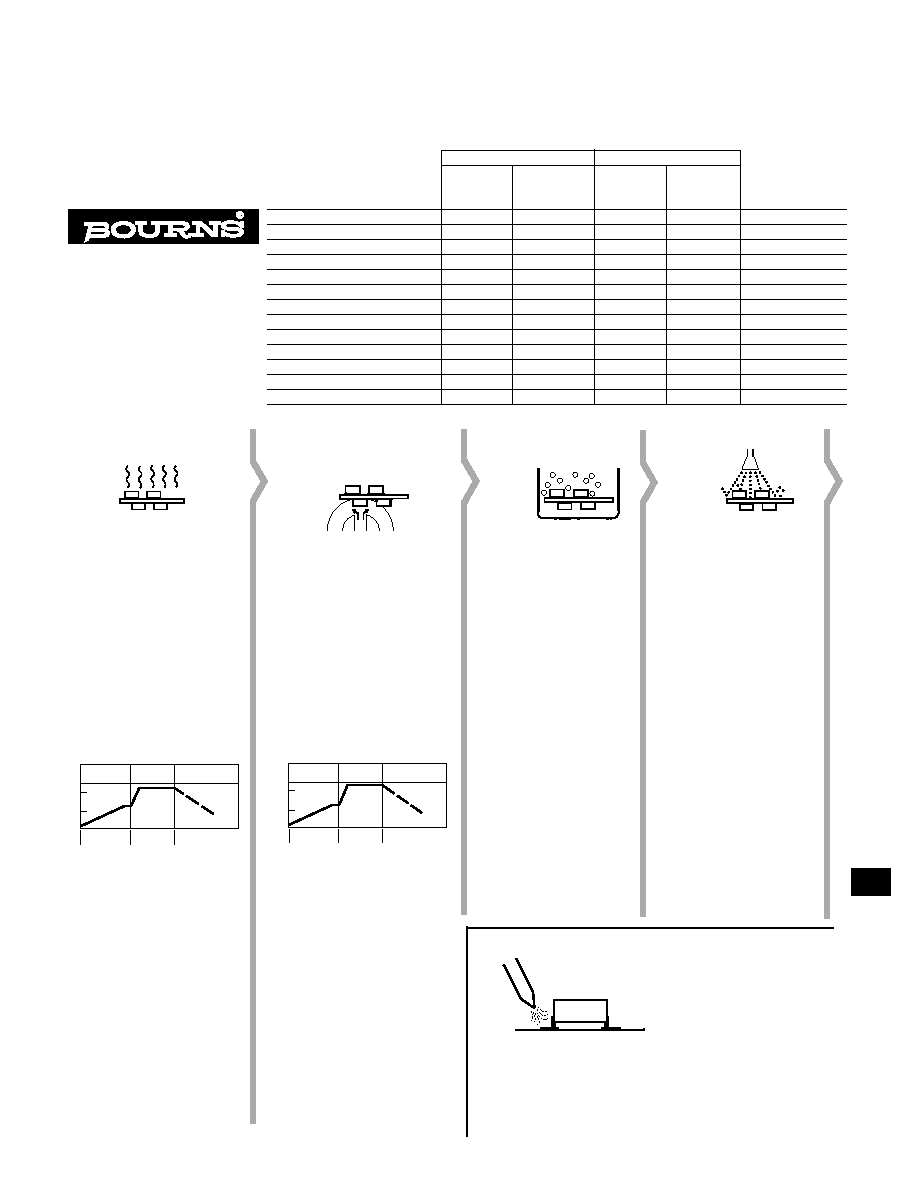- 您現(xiàn)在的位置:買賣IC網 > PDF目錄156623 > 4610M-902-104 Dual/Triple Ultra-Low-Voltage SOT23 µP Supervisory Circuits PDF資料下載
參數(shù)資料
| 型號: | 4610M-902-104 |
| 英文描述: | Dual/Triple Ultra-Low-Voltage SOT23 µP Supervisory Circuits |
| 中文描述: | KONDENSATOR NETZWERK |
| 文件頁數(shù): | 58/62頁 |
| 文件大小: | 1883K |
| 代理商: | 4610M-902-104 |
第1頁第2頁第3頁第4頁第5頁第6頁第7頁第8頁第9頁第10頁第11頁第12頁第13頁第14頁第15頁第16頁第17頁第18頁第19頁第20頁第21頁第22頁第23頁第24頁第25頁第26頁第27頁第28頁第29頁第30頁第31頁第32頁第33頁第34頁第35頁第36頁第37頁第38頁第39頁第40頁第41頁第42頁第43頁第44頁第45頁第46頁第47頁第48頁第49頁第50頁第51頁第52頁第53頁第54頁第55頁第56頁第57頁當前第58頁第59頁第60頁第61頁第62頁

Specifications are subject to change without notice.
337
These are the common
methods, materials and
maximum temperature/
time parameters for
soldering and cleaning
processes:
Soldering/Cleaning Methods
REFLOW
FLOW
Hot Air,
Infrared
Vapor Phase
Wave
Process Step
(Solvent)
(Aqueous)
Material
1.
Solder Paste Printing
X
RMA
2.
Adhesive Application
X
Epoxy
3.
Switch Placement
X
4.
Adhesive Cure
X
5. Flux Application
X
Rosin
5. Flux Application
X
Organic Acid
6. Solder (Reflow)
X
63/37 Sn/Pb
7. Solder (Flow)
X
63/37 Sn/Pb
8. Wash (Solvent)
X
ODS Free
9. Wash (Aqueous)
X
DI H2O; Detergent
High Pressure Fluids
X
Ultrasonics
X
Max. Temp.(°C)/Time (Seconds)
240/30
215/180
260/5
6
Solder
Reflow; Convection,
IR and Vapor Phase
GENERAL
Preheat sufficiently using both time
and temp. to bring the flux to activa-
tion and minimize thermal shock.
Consult your solder paste supplier for
the recommended profile.
RECOMMENDED
Typical IR/Convection profile.
Use convection or Vapor Phase when
possible and minimize the time above
reflow temperature.
CAUTION
Do not exceed time and temperature
reflow profile of 240°C for 30 sec. for
Hot Air/IR reflow and 215°C for 3
minutes for vapor phase reflow.
Minimize thermal shock by limiting
temperature ramps to 3°C/sec. and by
stabilizing board and component tem-
perature during preheating.
7
Solder
Flow (Wave)
GENERAL
For maximum component reliability
and performance, minimize the time
of temp. exposure above 200°C.
RECOMMENDED
Typical alloy is Sn63/Pb37. A typical
wave solder zone profile is 245C for
5 sec.
CAUTION
Always preheat before the soldier
wave using the temperature for flux
activation recommended by the man-
ufacturer.
Do not exceed 240C peak tempera-
ture for dual wave solder process
with a flow zone totaling 5 seconds.
Minimize thermal shock by limiting
temperature ramps to 3C/sec. and by
stabilizing board and component
temperature during preheating.
8
Wash
Solvent
GENERAL
Use solvent cleaning primarily
for nonpolar contaminants
such as rosin based flux
residues.
RECOMMENDED
Use any suitable washing sol-
vents that meet ODS require-
ments.
CAUTION
Limit excessive direct spray
pressure to 60 psi.
Allow the assembly to suffi-
ciently cool prior to the wash-
ing operation for minimized
thermal stress.
9
Wash
Aqueous
GENERAL
Use aqueous cleaning primarily
for polar contaminants such as
organic flux residues.
RECOMMENDED
Use De-ionized or Reverse
Osmosis water with multistage
rinsing. Post bake at 100C for
30 minutes to remove any resid-
ual moisture.
CAUTION
Limit excessive direct spray
pressure to 60 psi.
Allow the assembly to sufficient-
ly cool prior to the washing oper-
ation for minimized thermal
stress.
Board Rework Technique
GENERAL
Excessive and/or repeated high
temperature exposure may
affect the component perfor-
mance and reliability.
RECOMMENDED
Hot air reflow technique is pre-
ferred. Use No Clean or Rosin
based fluxes only, OA fluxes are
recommended.
CAUTION
Avoid the use of wave soldering
or soldering irons as a rework
technique. Avoid repeated and
excessive temperature exposure.
PRE-HEATING
(in air)
SOLDERING GRADUAL COOLING
(in air)
200°C
100°C
0°C
ONE MINUTE
MIN.
20 SECOND
MAX.
230°C
PRE-HEATING
(in air)
SOLDERING GRADUAL COOLING
(in air)
200°C
100°C
0°C
ONE MINUTE
MIN.
5 SECOND
MAX.
245°C
相關PDF資料 |
PDF描述 |
|---|---|
| 4610X-101-101 | WIDERSTAND NETZWERK DICKFILM 100R 5ST |
| 4610X-101-102 | Dual/Triple Ultra-Low-Voltage SOT23 µP Supervisory Circuits |
| 4610X-101-103 | WIDERSTAND NETZWERK DICKFILM 10K 5ST |
| 4610X-101-104 | Dual/Triple Ultra-Low-Voltage SOT23 µP Supervisory Circuits |
| 4610X-101-105 | WIDERSTAND NETZWERK DICKFILM 1M 5ST |
相關代理商/技術參數(shù) |
參數(shù)描述 |
|---|---|
| 4610M-902104LF | 制造商:Bourns / JW Miller 功能描述:Cap Ceramic Network 0.1uF 50V X7R 20% SIP 5 Capacitor 125°C 制造商:Bourns 功能描述:Cap Ceramic Network 0.1uF 50V X7R 20% SIP 5 Capacitor 125°C |
| 4610M-902-104LF | 功能描述:電容器陣列與網絡 10Pin 0.1uF 20% Isolated X7R RoHS:否 制造商:AVX 電容:0.1 uF 容差:20 % 電壓額定值:6.3 V 元件數(shù)量:2 工作溫度范圍: 外殼長度:0.8 mm 外殼寬度:1.6 mm 外殼高度:0.5 mm 端接類型:SMD/SMT 系列:PG |
| 4610M-AP1-472LF | 制造商:Bourns Inc 功能描述: |
| 4610M-AP2-104DLF | 功能描述:電阻器網絡與陣列 10Pin 2% 100K Isolated RoHS:否 制造商:Vishay/Thin Film 產品類型:Networks 電路類型:Divider 電阻器數(shù)量: 電阻數(shù)值:10 kOhms 容差:0.1 % 溫度系數(shù): 管腳數(shù)量:3 工作溫度范圍:- 55 C to + 155 C 尺寸:1.02 mm W x 3.05 mm L x 1.4 mm H 引線間隔: 端接類型:SMD/SMT 封裝:Reel |
| 4610M-LF | 制造商:BOURNS 制造商全稱:Bourns Electronic Solutions 功能描述:Networks |
發(fā)布緊急采購,3分鐘左右您將得到回復。